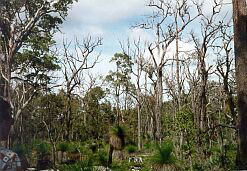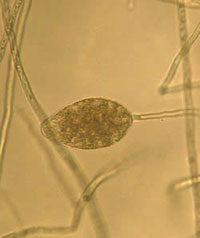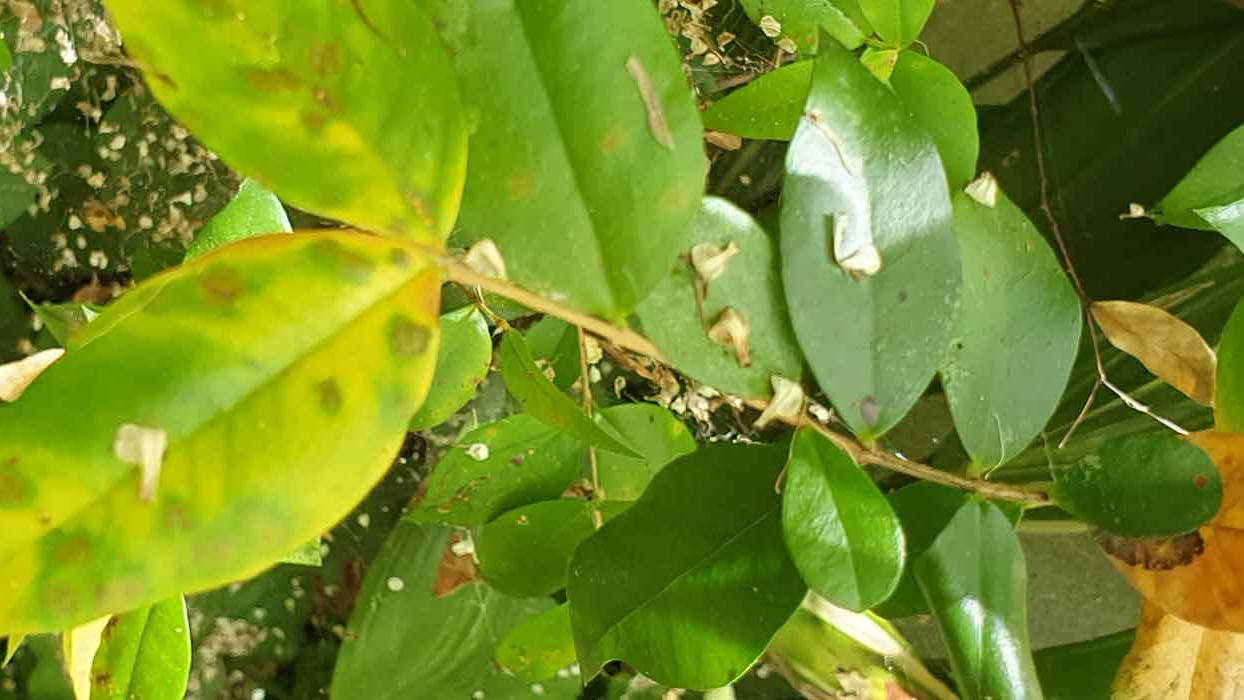
The fungus Phytophthora (Fye-toff-thra) root rot has caused quite a few disasters as it’s traveled around the world. One species (P. infestans) was responsible for the Irish potato famine. Late blight (or Irish blight) of potatoes wiped out season after season of potato crops across Ireland in the 1800s. Potatoes were the staple food in Ireland at the time, often eaten three or four times a day. The result was a famine that decimated the population.
And now another devastating species, P. cinnamomi has found a new home in Australia. It’s likely to have been introduced with European settlement and is now found in Western Australia, Victoria, Tasmania, South Australia and coastal Queensland, where it is having a devastating affect on hundreds of thousands of hectares of native vegetation.
Western Australia in particular has been badly hit with the disease. It has infected the majestic jarrah forests in Western Australia, where it is slowly killing vast areas of vegetation, including the trees.
It’s a fungus
P. cinnamomi is a fungus that grows through the root system (and sometimes the stem) of a plant. It can only be seen using a microscope.
It destroys the root system, thereby preventing the plant from taking in water and nutrients. In fact, infected plants usually die from lack of water and nutrients. Some plants can survive the disease.

The fungus releases spores into the surrounding soil, which travel in soil water to infect the next plant. The microscopic image shown here displays sporangia, which release spores.
Interestingly, Phytophthora root rot does not usually cause a lot of damage in undisturbed vegetation in areas where annual rainfall is less than 600 mm.
Symptoms
It’s difficult to diagnose the disease accurately without relying on laboratory tests and it can be confused with a number of other non-disease problems, such as drought stress.
Leaves may develop brown patches at the tips and margins and there is generally a yellowing off and dying back of foliage. The foliage dries out and young feeder roots darken. When it attacks large mature trees, the disease can take years to kill the plant.

Prevention the Only Cure
The alarming spread of P. root rot in Australia is accompanied by the fact that efforts to control it so far have failed. Research is focusing on examining the vulnerability of plant species and communities, especially the high risk vegetation, and on the ecology of the fungus itself.
The only real way to combat the disease at this point in time is by limiting the spread of the fungus. Once the disease has established the next focus is on reducing its impact. A combination of quarantine, hygiene and treatment with the chemical phosphite are the current control methods.
Quarantine is particularly important in protecting areas of high conservation value. Hygiene measures, such as sanitising tools, machinery, boots and tyres helps prevent the fungus from spreading as a result of human activity. Phosphite is used as a spray on infected plants with some success and does induce long-lasting resistance against the fungus. It has a low toxicity for mammals and breaks down quickly in the soil, but at high levels it can be harmful to certain plant species.
Phosphite must be used carefully, as more research is required to fully determine its limitations and optimal methods of use. Spraying with phosphite gives about 2 years control of the fungus, whereas stem injections will give about 5 years control.
Unfortunately, treatment with phosphite is not sustainable, as it needs to be repeated frequently. Phosphite is also subject to regulations regarding its use, which varies from state to state. Check with your local DPI before considering its use.
The fungus has another advantage in that the spores can live for up to 10 years in the soil, and the fungus itself can live up to 20 years.
Information sources:
Plant Protection 1, by Kerruish, R.M. & Unger, P.W., 2003, RootRot Press, ACT.
Australian Government, Department of Environment & Heritage
Images (from top) courtesy of DPI, Victoria; DSE, Victoria; and USDA Forest Services.
Related Articles:
Low Impact Pest Management 101 Video
Sustainable Gardening 101 Video Series PART 3: Low Impact Pest Management Gardens are the natural habitat for all types of insects – the good, the…
Myrtle Rust is a Spreading Problem
Myrtle rust is a spreading problem in Australia. It is a fungus, Puccinia psidii, which affects plants in the family Myrtaceae. While there are…




